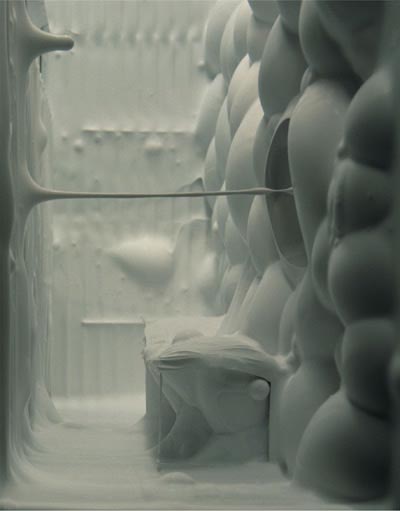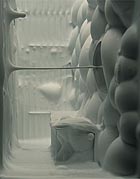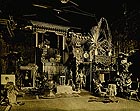
translated and summarized by: Liz Wollner-Grandville,
English summaries June 14 - 26
Secession
Saskia Olde Wolbers
27.05.11 – 21.08.11
Illusions and memory space
Off-key voices, psychedelic tones and sounds of nature, images of organically flowing spaces and of biomorphic entities. When the video artist, Saskia Olde Wolbers, tells stories, reality begins to drift into an abstract, traumatic condition. The Dutch-born artist transforms information from news, myths or fragments of daily conversations into surreal, seemingly claustrophobic film-like settings, which, in the end, leave the listener to his imagination. Because the image planes themselves are curiously uncoupled from the stories heard from the off. On account of a disturbing parcourse of highly artificial abstract worlds the visitor of this exhibition believes himself to be in the basement of the Secession. Three video works of the artist strike a reflective cord about the suggestive power of the pictures and the verisimilitude of the conveyed events - however they are presented.
"Placebo" (2002), tells the story of a man who, for many years, deceived his fellow human beings into believing he was a doctor. The monologue is recited from the perspective of his loved one who, after they have both been involved in a car accident, finds herself in a hospital ward where the man is lying in a coma. A room devoid of people (the model of a ward) mutates into a fluid setting: liquid, clinically pallid white slops out of one corner of the room into the others forming droplets and bubbles. If you're looking for symbols of recalled memories - which are immediately swept away from one's train of thoughts - you'll find them in Olde Wolber's "Placebo".
Hybrids of birds and plants enliven the images of her latest production, "Pareidolia". However, here there's nothing to be felt of the balancing act between reality and illusion, which is repeated time and again in the artist's works. Here, Saskia Olde Wolbers presents the artistic and constructive character - as seen in her other works - before your very eyes, so that one is hardly tempted to trawl through her stories for particles of truth. And when fiction covers the real to such an extent, the illusion is perfect
By Manisha Jothady
Secession
1010 Vienna, Friedrichstrasse 12
Tel: 01/587 53 07
Fax: 01/587 53 07-34
www.secession.at
Opening hours: Tue-Sat 10 a.m. – 6 p.m., Sun 10 a.m. - 4 p.m.
Schwarzenbergplatz
The Morning Line - Vienna
08.06.11 - 20.11.11
Oddly sonorous
Twenty tons of blackened aluminum and some steel poured in fractal geometric shapes whose basic structure forms pyramids with three-cornered basal areas: following guest visits in Venice, Seville and Istanbul, "Morning Line" is a three-dimensional artistic manifestation of cosmic regularities which has now landed in Vienna in front of the Hochstrahl Fountain on Schwarzenbergplatz.
Everything started about seven years ago when Francesca Habsburg, the charismatic head of the Thyssen-Bornemisza Art Contemporary (T-B A21) Foundation, asked the artist, Matthew Ritchie, to create a project that should portray no less than a three-dimensional reflection of the universe. Consequent to the fact that the universe is extremely variegated, it soon became clear that music and other artistic forms of expression would come into play. "I love breaking rules", says Francesca Habsburg, whose floating, interdisciplinary project should form a universal symbiosis in which art, architecture, performance, science, music, film, computer and graphic design and other disciplines played a role.
And so the idea of "Morning Line" was born, a temporary, mobile pavilion, which could easily be dismantled, put into containers and transported around the whole world and - providing permission had been given - erected again in any desired place. "Morning Line" is a concept that allows the work to enter into a dialogue with the people, the city and public space that it temporarily occupies. For this, Matthew Ritchie, the architects Benjamin Aranda and Chris Lasch and Arup AGU developed a modular structure of tetrahedrons in four sizes. They are easily dismantled and can assume different guises in accordance with their parametric design. Added to this, Tony Myatt, Professor of Music Research Centre of the University of York and his students programmed the intersections between sound technology and spatial structure so that "Morning Line" also functions as sound instrument.
With a height of about nine meters, the Vienna version of "Morning Line" spans approximately 23 meters and, with its fractal elements, creates two cavernous vaulted spaces, which define both a diaphanous as well as a definitive contained area. The opening in the centre incorporates the axis of the Schwarzenberplatz, while the points of the hybrid sound sculpture intone a dialogue with the houses at its perimeter.
The musical programming is also geared to Vienna: curator Franz Pomassl selected 28 musicians to compose the music; ranging from Ghostigital to Carsten Nicolai, Mehmet Can Özer, Zavoloka to Christian Fennesz. And for the first time, there are video projections accompanying the sound installation, which can be experienced on the Schwarzenbergplatz round the clock until 20 November.
By Isabella Marboe
Schwarzenbergplatz
1010 Wien,
www.tba21.org
Künstlerhaus Wien / Unteres Belvedere
Makart. Painter of the senses. / Makart. An artist rules the city
09.06.11 - 16.10.11
Meat and filler
Red is a colour for traffic lights, stripes on ambulances and lipsticks, a conspicuous, much-spread colour, and paintings that deserve such a red should be worthy of this honour if the pictures are good. Honour for the painter, Hans Makart, is demonstrated in two locations in cooperation with three houses.
It feels as if three thousand, two hundred and twenty-eight important details are presented, mentioned and discussed in numerous exhibits under Hans Makart's marketing surname - "Painter of the senses" in the Belvedere and "An artist rules the city" in the Künstlerhaus. It seems as if they attempt to come to grips with the Dumba Room, with the atelier that Rudolf von Alt tenderly portrayed in every detail (Künstlerhaus), with the velvety curtains in lilac and pistachio that enhance the magnificence of the pictures by a real and rapt creamy embellishment (Belvedere) and the threshold to modernity.
The threshold to modernity before which they all stand, and unfortunately no longer fit into the modern, is important also in an international art contextual development, and beside a picture of a lady by Makart in the Belvedere, one also sees a picture of a lady by Makart's contemporary, Manet. Makart uses more red and more colour which doesn't have to mean anything bad. More exactly, Manet uses so little colour for his portrait of a lady that one could consider Manet's picture dry. Manet's lady doesn't wear a fur, Makart's lady does. It's nothing to do here with the correctness of keeping fur-bearing animals, but rather with the puttied mess that Manet could not produce in a fur collar and which attested Makart's alleged fear of his embarking on the modern. Abstraction is quackery with Makart. He doesn't come across as a painter who found his work difficult or dry. Makart was a painter who worked his atelier in the same way as cinema owners later worked their cinemas; he took entry fees and marketed his works manifoldly and professionally. Today, Vogue would contact him in order for his atelier to appear in a fashion magazine. At that time, everyone who had nothing better to do went there and found pleasure in cultivated collective voyeurism. It's lucky that Makart had nothing better to do than paint firm-bosomed wonders and magnificent furs with artistic dark pucker ornaments in every possible position and gives so much space to a funny, silicon-like rubbery mass of humanity. Otherwise, he organized a grandiose procession. Pity that films had not yet been invented.
The red in his pictures appears to have been masterfully applied and flickers cautiously. One can see that the pictures truly pleased Makart and many others but it is not evident why they should continue to please. If Makart had been a painter of steak, he could have patronized vegans enormously.
By Charles Nebelthau
Unteres Belvedere
1030 Vienna, Rennweg 6
Tel: +43 1 795 57-200
Fax: +43 1 795 57-121
www.belvedere.at
Opening times: Daily from 10 a.m. - 6 p.m, Wednesdays 10 a.m. - 9 p.m.
Künstlerhaus Wien
1010 Vienna, Karlsplatz 5
Tel: 01/587 96 63
www.k-haus.at
Opening times: Daily from 10 a.m. - 6 p.m
Architektur im Ringturm
Stadt. Beispiel. Bozen. - Entwicklung Bahnhofsareal
10.06.11 – 08.07.11
Green belt and quartz
Nobody could have foreseen the developments train stations might trigger in the 21st century. The modernization of railway tracks and stations is only one aspect of restructuring train stations – yet much more important than promoting public transport is the enormous potential for municipalities, states and companies to develop the newly available space. Stuttgart and Vienna are only two examples.
At the beginning of this year, an international competition asked participants to submit their visions for the layout surrounding the 150 year-old Bolzano train station. The winning project by Austrian architect Boris Podrecca and the landscape architects Auböck +Kárász, as well as eight other drafts are currently presented in the exhibition room of the Ringturm – a venue once reconstructed by Podrecca.
The displayed visions are enlightening, if nothing else because they say much about how architects deal with the givens of historical cities. Podrecca and Auböck+Kárász relocated the railway lines, created green belts on the old tracks and structured new residential and commercial buildings by adding pedestrian zones and squares. Ben van Berkel and Daniel Libeskind maintained the routing as it was and accentuated the newly built quarter with 60m high quartz-like solitaires.
By Iris Meder
Architektur im Ringturm
1010 Vienna, Wiener Städtische Allgemeine Versicherung
AG, Schottenring 1
Tel: +43 1 531 39 Ext: 1115 or 1101
www.vig.com/de/presse/biddatenbank/architektur-im-ringturm.html
Opening hours: Mon – Fri 9 a.m. – 6 p.m.
Mehr Texte von translated and summarized by: Liz Wollner-Grandville


 Teilen
Teilen






